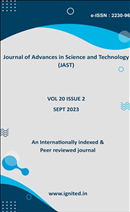Crop Yield Prediction and Classification using the Agriculture Resources and Data Mining Techniques
DOI:
https://doi.org/10.29070/krwa0448Keywords:
Agriculture, Resources, , Crop Yield Prediction and Data Mining, TechniquesAbstract
This study investigates the application of data mining techniques in meteorological forecasting to enhance crop yield prediction accuracy Moreover, the integration of meteorological forecasting with agronomic models and geographical information systems (GIS) facilitates site-specific crop management and precision agriculture practices. By combining meteorological data with soil properties, crop phenology, and socio-economic factors, data mining techniques enable the development of predictive models that enhance crop yield potential and optimize resource allocation. By leveraging advanced data analytics and machine learning algorithms, agricultural stakeholders can make informed decisions, mitigate risks, and enhance productivity in the face of changing climatic conditions and environmental uncertainties.
Downloads
References
Mishra, S. P. (2018). Use of Data Mining in Crop Yield Prediction. Proceedings of the Second International Conference on Inventive Systems and Contro (pp. 796-802). IEEE.
Balducci, F., Impedovo, D., & Pirlo, G. (2018). Machine Learning Applications on Agricultural Datasets for Smart Farm Enhancement. Machines, 6, 38.
Gandhi, N., Armstrong J. Leisa, (2016), Rice crop yield prediction using artificial neural networks, IEEE International Conference on Technological Innovations in ICT For Agriculture and Rural Development (TIAR) 105.
Gandhi, N., Armstrong J. Leisa, Owaiz P., (2016), Predictingrice crop yield using bayesian networks, Intl. Conference on Advances in Computing, Communications and Informatics (ICACCI), Sept. 21-24, Jaipur, India.
Anusha A. Shettar, S. A. (2016). Efficient data mining algorithms for agriculture data. International Journal of Recent Trends in Engineering & Research, 142-149.
Rajshekhar Borate., “Applying Data Mining Techniques to Predict Annual Yield of Major Crops and Recommend Planting Different Crops in Different Districts in India”, International Journal of Novel Research in Computer Science and Software Engineering,Vol. 3, Issue 1, pp: (34-37), April 2016.
D Ramesh, B Vishnu Vardhan, “Analysis of Crop Yield Prediction using Data Mining Techniques”, International Journal of Research in Engineering and Technology (IJRET),Vol.4, 2015.
Veenadhari, S., Bharat Misra, D Singh, “Data mining Techniques for Predicting Crop Productivity – A review article”, IJCST, International Journal of Computer Science and technology march 2011.
DakshayiniPatil, Dr. M .S Shirdhonkar, “Rice Crop Yield Prediction using Data Mining Techniques: An Overview”, International Journal of Advanced Research in Computer Science and Software Engineering, Volume 7, Issue 5, ISSN: 2277 128X,2017.
Ramesh A. Medar and Vijay. S. Rajpurohit “A Survey of data mining techniques for crop yield prediction”, IJARCSMS, Volume 2, Issue 9, September 2014 pg. 59-64.
D, Ashok Kumar and Kannathasan, N (2011) A Survey on Data Mining and Pattern Recognition Techniques for Soil Data Mining, International Journal of Computer Science Issues, Vol. (8).
Geetha, M.C. (2018), A Survey and Analysis on Regression Data Mining Techniques in Agriculture, International Journal of Pure and Applied Mathematics, Vol 118 No. 8, 341-347.
Ramesh Vamanan, K. Ramar (2011), Classification of agricultural land soils a data mining approach, International Journal on Computer Science and Engineering, Vol. 3(1).
Vagh, Y. (2012), An investigation into the effect of stochastic annual rainfall on crop yields in South Western Australia, Paper presented at the International Conference on Knowledge Discovery.
Dissanayake, D. & Rathnayake, R. & Chathuranga, Gihan. (2023). Crop Yield Forecasting using Machine Learning Techniques - A Systematic Literature Review. KDU Journal of Multidisciplinary Studies. 5. 54-65. 10.4038/kjms.v5i1.62.






